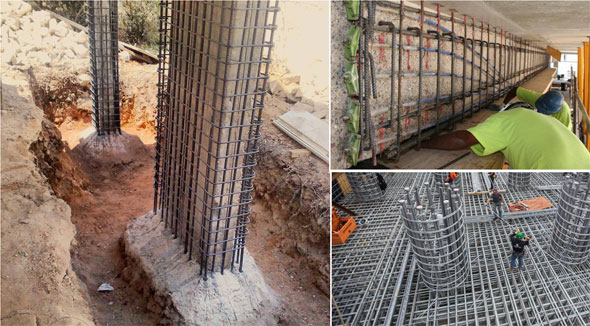Strengthening of structures with external post-tensioning methods
- Concrete Cost Estimator
- Concrete Continuous Footing
- Landscape Bidding and Estimating
- Construction Cost Estimating
- Concrete and steel cost estimation
- Construction Cost Estimate Breakdown
- Construction Estimating Worksheet
- Home Construction Cost Estimate
- Estimate Pricing Sheet
- Sheet for General Contractor
- Construction Cost Estimate
- Labor Materials Cost Estimator
- Masonry Estimating Sheet
- Sheet for Building Contractor
- Construction Schedule Bar chart
- General Cost Estimator Sheet
- General Construction Estimate
- Building and Road Estimating Sheet
- Detailed expense estimates
- Door and Window Takeoff Sheet
- General Construction Cost Estimating Sheet

The main purpose for strengthening of concrete structures is to improve the strength of existing components to bear new loads or to settle an existing shortcoming.
There are various strengthening methods like section enlargement, externally bonded fiber reinforced polymer (FRP) reinforcement, supplemental steel elements, and post-tensioning to raise the load bearing strength and enhance the functionality of existing structures. While choosing a strengthening method, several technical factors should be taken into consideration. Besides, focusing on serviceability, strength, durability, appearance, and fire rating, other non-technical factors like constructability, aesthetics and cost should also be considered.
The reinforcing concrete structures along with a concrete or steel jacket enhance the compressive and shear strength and retain enclosure to make the ductility or bonding of concrete and reinforcement better.
There are two types of strengthening systems like Passive systems and active systems.
Passive strengthening systems do not set up forces to the structure or its components. Passive systems like steel reinforced concrete enlargement and the inclusion of structural steel components aid in load sharing and the overall resistance of the member while it deforms in accordance to external loads.
For this reason, the efficiency and load sharing of passive systems considerably influences their axial and bending stiffness. Other instances of passive strengthening systems contain the application of bonded steel plates and externally bonded FRP.
Also Read: Brief overview of Reinforcement Concrete
Active strengthening systems, like external post-tensioning (PT), require the entry of external forces to the structural elements that would offset fraction or all of the effects of external loads. For instance, new post-tensioned mono-strands are formed along the span of a prevailing beam to create uplift at mid-span that can be employed to offset prevailing strength shortage or facilitate the member to support extra load.
Active systems are normally employed in load sharing instantly as soon as installation is finished and offer strength growth and immediately enhance the service performance, like lessening tensile stresses (or cracking) and deflections. Strengthening with PT is specifically suitable and inexpensive for long-span beams and cantilevered members, and successfully applied to raise the bending and shear resistance and rectify excessive deflections.
How Post-Tensioning Works: Post-tensioning is the launching of external forces to the structural member with high strength cables, strands or bars. The PT reinforcement is attached with the existing member at anchor points, generally situated at the ends of the member, and profiled along the span at basically situated high and low points. If stressed, the tendons will develop upward forces (at low points) or downward forces (at high points) to produce reverse loading on the member.
PT strengthening systems are segregated into two categories, External and Internal. External PT comprises of uncovered cables or steel bars that are secured directly to the structure. As the reinforcement is situated outside the member, its utilization is restricted by fire rating and durability requirements.
To make stability better, systems comprising of sheathed cables and coated anchors are utilized. Instead, the external cables are arranged inside plastic ducts and then filled with cementitious grout.
An internal PT system, conversely, comprises of PT reinforcement that is set inside the original member. It can be obtained by setting the new PT reinforcement in cores provided along the axis of the member, trenches chipped along the span of the member, or by arranging the reinforcement in a new concrete enlargement bonded to the existing member. The latter is generally more when a comparatively large increase in strength and/or rigidity is necessary. An internal PT system can also deal with all fire rating and durability concerns.

- Application of concrete calculator
- Roofing Calculator can streamline the roof estimating process
- House construction cost calculator
- Engineering column design excel spreadsheet
- Material Estimating Sheet with Excel
- Materials List and Cost Estimate Worksheet
- Concrete Slab Estimating Calculator Sheet
- Common types of foundations for buildings
- Online calculation of construction materials
- Estimating with Excel for the Small Contractor
- Concrete Beam Design Spreadsheet
- Virtual Construction Management app for construction
- Autodesk’s Project Skyscraper
- Reed Construction’s Reed Insight
- Manage your construction project documentation
- Costimator, the popular cost estimating software
- On Center Software for construction professionals
- Free Construction Estimating Software
- Plumbing Calc Pro
- Cost Estimate Worksheet
- HVAC Piping Quantity Takeoff Worksheet
- Construction Estimating Software Sheet
- Estimate Cost Templates
- Construction Punch List
- Construction cost estimating template consisting estimating basic
- Gantt Chart Template for Excel
- Download Civil Engineering Spreadsheets with Verification
- The Building Advisor Estimating and Budgeting Worksheet
- Spreadsheet for design of concrete bridge
- Construction Estimating Software Free








